how thick is the skin on your shins tattoo
Thinking about a tattoo on your shins? It’s key to know the skin’s unique traits. The skin on your shins is very thin, about 1.3 to 1.5 millimeters thick. This is much thinner than skin on your thighs or upper arms.
This thin skin and its closeness to bone make getting a tattoo here painful. The tattoo needle hits nerve endings and bone more easily. This makes the pain more intense compared to thicker skin areas.
Knowing about your shin skin is vital before getting a tattoo. It helps you prepare for the experience and ensures a good outcome. Whether you’re new to tattoos or have many, understanding shin skin is important. It helps you make a smart choice and know what to expect.
Table of Contents
Understanding Tattoo Pain
Tattoos involve injecting ink into the skin with needles, causing discomfort. The pain level can vary a lot. Factors like skin thickness, bone and nerve proximity, pain tolerance, age, and gender all matter.
Factors that Affect Tattoo Pain
Areas with thinner skin, like the shins, are more painful to tattoo. This is because there’s less skin and muscle to cushion the needle. On the other hand, areas with more fat and muscle, like the outer thigh, are less painful.
Your age and gender can also affect how much you feel during a tattoo. A study found that females might feel more pain than men. Older or obese people might bruise more and feel more pain due to looser skin.
Smoking can also impact pain during tattooing. Smokers might feel more pain because nicotine affects the body’s pain response.
“Different types of pain during tattooing include dull pain, vibrating pain, burning pain, scratching pain, and sharp or stinging pain.”
Your pain tolerance for tattoos, what affects tattoo pain, and tattoo pain by location can vary a lot. Knowing the tattoo pain reasons can help you prepare and manage the discomfort during your tattoo session.
Most Painful Places to Get Tattooed
Some body parts are more painful to get tattooed than others. The ribs, fingers, groin, head, and armpits are the most sensitive. Thin skin, bones, and nerves nearby, and less fatty tissue make these areas very painful.
Tattoo artists say armpit and ribcage tattoos hurt a lot, both at 9 out of 10. Ankle, shin, foot, and toe tattoos also hurt a lot, at 9 out of 10. But, nipple and breast tattoos are less painful, at 7 out of 10.
The groin area is also quite sensitive, with tattoos there rated at 8 out of 10. Elbow tattoos are at 8, and knee tattoos are the most painful, at 10 out of 10. Hip tattoos are also quite painful, at 8 out of 10.
Other areas known for their pain include the neck and spine (7 out of 10), the head, face, and ears (8 out of 10), and the hands and fingers (8 out of 10). Lip tattoos are slightly less painful, at 6 out of 10.
“The level of pain during a tattoo session varies depending on personal factors such as pain threshold and the size/complexity of the tattoo,” explains tattoo artist Anka Lavriv.
Everyone’s pain tolerance is different. Knowing which tattoo spots hurt more can help you choose wisely. Being ready for the most painful tattoo spots can make your tattoo experience better.
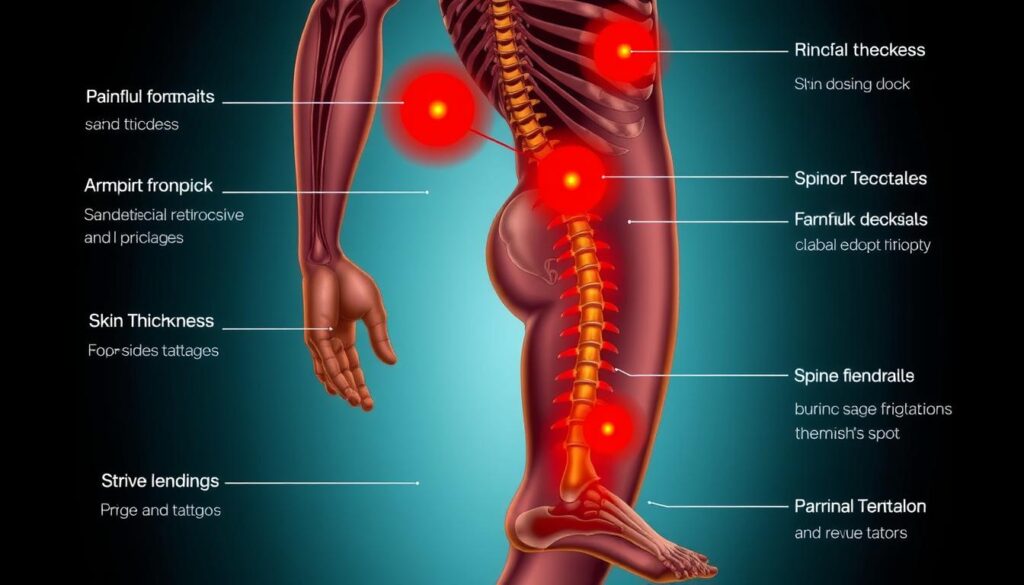
how thick is the skin on your shins tattoo
The thickness of your skin affects the pain and healing of tattoos. The shins have very thin skin, between 1.3 and 1.5 millimeters. This makes them a sensitive and potentially painful spot for tattoos.
Shin Bones or Ankles Tattoo
Tattoos on the shins or ankles can be quite uncomfortable. The thin skin and closeness to the bone make these areas very painful. The tattoo needle feels like it’s hitting the bone, causing intense pain.
Everyone feels pain differently, but shin tattoos and ankle tattoos are often very painful. The thin skin on shins makes tattoos on shin bone a tough and uncomfortable experience for many.
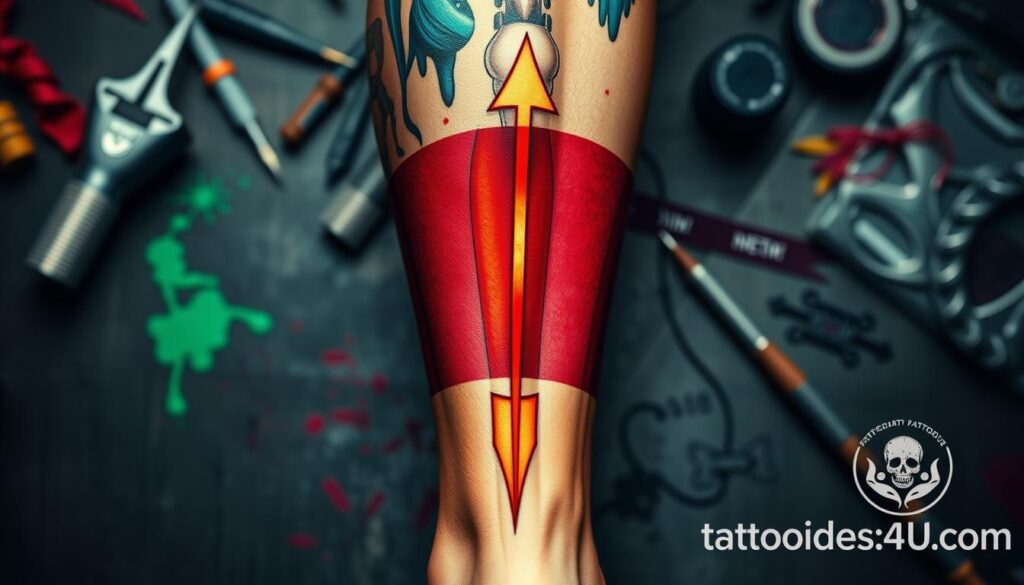
“The skin on the shins is quite thin, with little fat or muscle cushioning the bone underneath. This makes shin tattoos particularly painful, as the tattoo needle is in close proximity to the sensitive shin bones.”
Remember, ankle tattoo pain can also be high because of the thin, sensitive skin. Proper preparation, pain management, and aftercare can help reduce discomfort from these tattoos.
Least Painful Places to Get Tattooed
Not all body parts hurt the same when getting a tattoo. Some areas are known to be less painful. These spots have thicker skin, fewer nerves, and more muscle. They’re great for your first tattoo or big designs.
The forearm is often seen as a easiest place to get tattooed. Its thick skin and fat make it less painful. The upper back is also a low-pain tattoo location because of its thick skin and padding.
The outer thighs are another good choice for those looking for tattoo spots with less pain. The muscle and fat here reduce the needle’s sensation. The calves are also known for being least painful tattoo areas because of their muscle and fewer nerves.
Your own tattoo pain tolerance matters a lot. But choosing these less sensitive least painful tattoo spots can make your tattoo experience more comfortable and enjoyable.
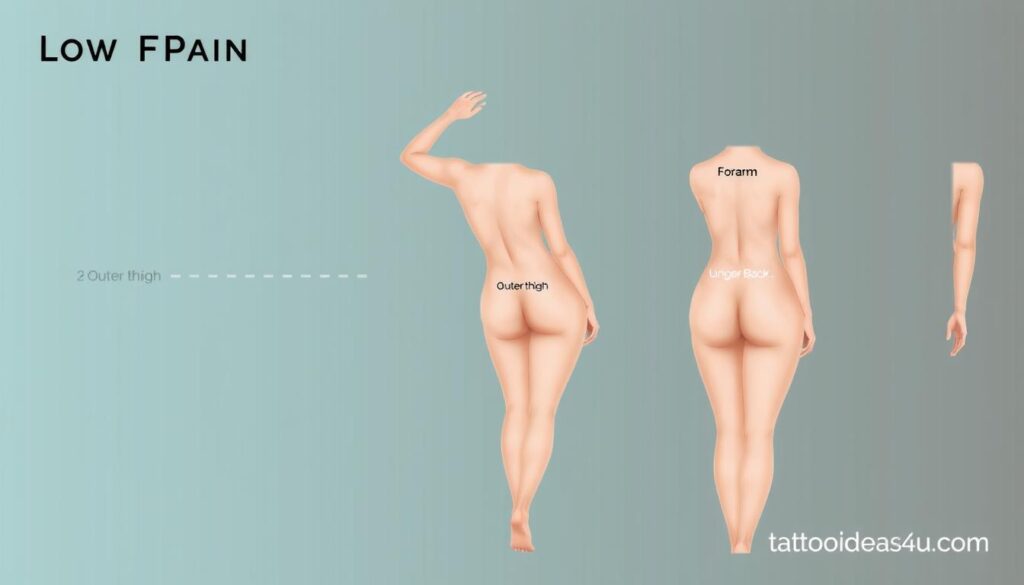
“The decision to get a tattoo should be based on personal preference, not fear of pain. By choosing a less sensitive area, you can focus on the artistic expression and personal significance of your tattoo.”
Preparing for Tattoo Pain
Getting a tattoo is exciting, but the pain can worry you. Luckily, there are steps to prepare and manage the pain. Knowing what affects tattoo pain and using pain relief can make your experience better.
Pain Relief Tips
Using a numbing cream is a great way to handle tattoo pain. These creams numb the area, making the needle feel less. Apply the cream 30 minutes before your tattoo to work best.
Also, focus on your breathing and relax. Taking breaks, drinking water, and avoiding certain substances before your tattoo can help. These steps make the process more comfortable.
- Use a numbing cream 30 minutes before your appointment
- Practice deep breathing and relaxation techniques
- Stay hydrated and avoid painkillers or alcohol before your tattoo
- Take breaks during the session if needed
The pain you feel can change based on your pain tolerance, tattoo location, and design size. By preparing and using pain relief, you can handle the tattooing better. And you’ll love your new body art.
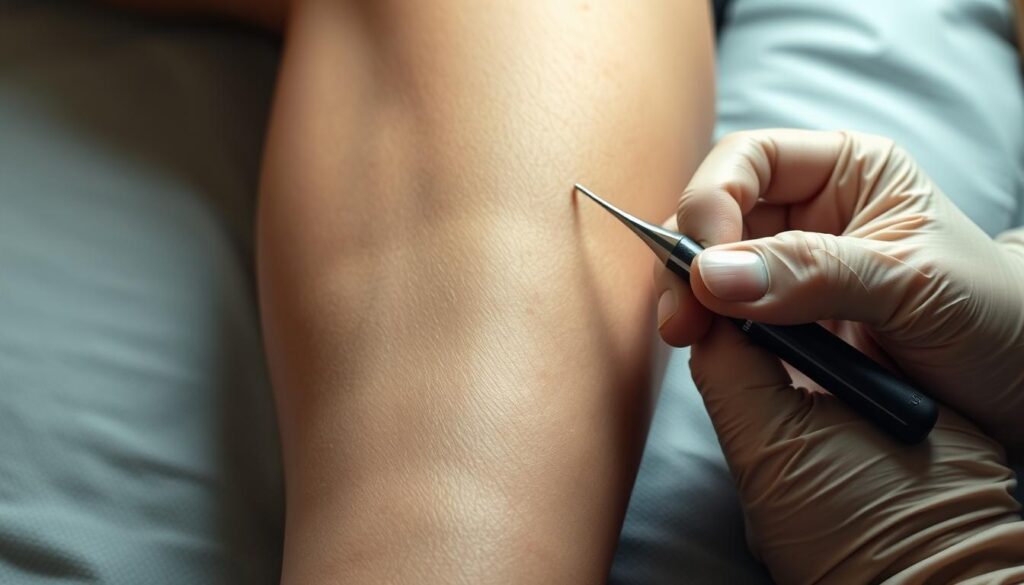
Tattoo Placement and Size Considerations
When planning a new tattoo, the placement and size are key. You should think about visibility, skin condition, and the artwork’s complexity. Larger tattoos can have detailed designs but might hurt more. Smaller tattoos in less sensitive spots can be less painful.
The upper arm is one of the least painful places for tattoos. Its thicker skin and muscle help cushion the needle. The thigh area, especially the outer thighs, is also less painful due to muscle and fat.
Rib tattoos are very painful because of the thin skin and bones nearby. They are considered high-pain areas. Forearm tattoos heal quickly but need protection from sun and physical contact.
Tattoo placement affects pain tolerance. Upper arms are less painful than neck or hand tattoos. Popular spots include the arms, back, chest, and legs.
Larger tattoos on the back, chest, outer thighs, and upper arms can hold detailed designs. But, tiny tattoos can blur over time. Tattoos on the face, neck, hands, and chest make a bold statement but can change how people see you.
The best tattoo placement and size depend on your preferences, pain tolerance, and design. Always talk to a professional tattoo artist to make the right choice for you.
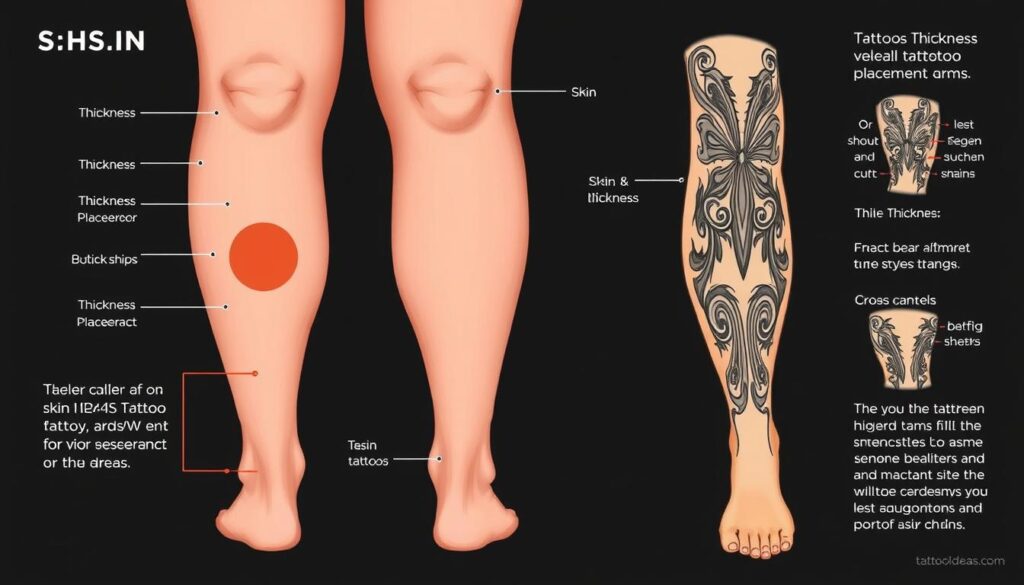
“Placement can impact pain tolerance: upper arms less painful than neck or hand tattoos.”
Aftercare and Healing Process
Proper tattoo aftercare is key for managing pain and ensuring your new ink heals right. It’s important to follow your artist’s post-care instructions closely. This means keeping the tattoo clean, moisturized, and protected as it heals.
Post-Care Instructions
The healing of a tattoo can take weeks and may cause some discomfort, swelling, or scabbing. Sticking to the recommended aftercare routine can help reduce these issues. Here are some tips to remember:
- Gently clean the tattooed area with warm water and a mild soap or cleanser, avoiding harsh scrubbing.
- Apply a thin layer of fragrance-free, hypoallergenic moisturizing lotion or ointment to keep the skin hydrated.
- Protect the tattoo from direct sunlight by covering it with loose, breathable clothing or applying a high-SPF sunscreen.
- Avoid picking at scabs, exfoliating the area, or submerging the tattoo in water until it’s fully healed.
Remember, the healing process can take up to 4 weeks. So, be patient and diligent with your tattoo aftercare. By following these tattoo aftercare tips, you can ensure your new how to care for a new tattoo heals beautifully and tattoo healing stages are smooth.
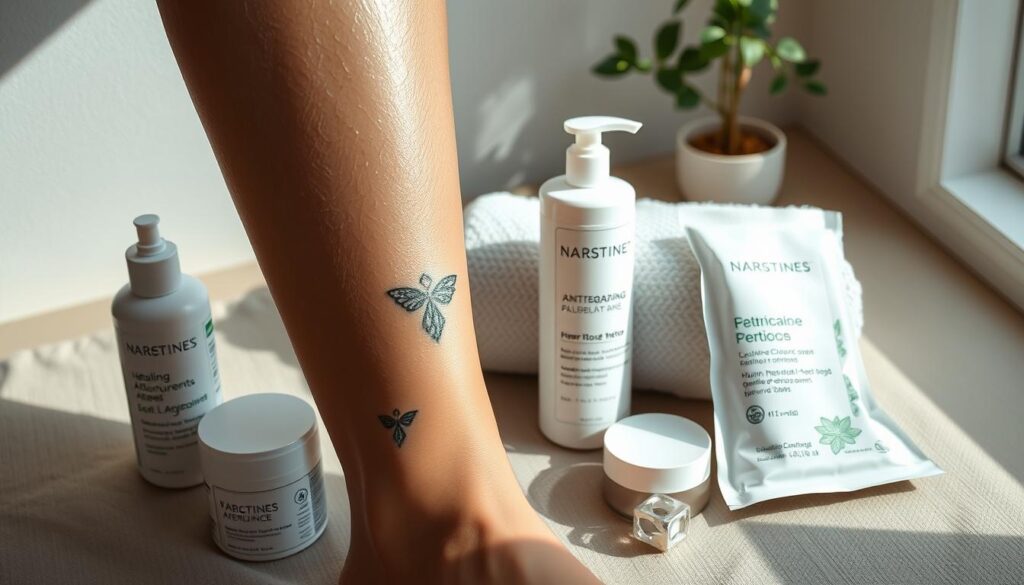
If you notice any signs of infection, such as fever, increased pain, redness, or drainage, seek medical help right away. Proper aftercare is crucial for the long-term health and vibrancy of your tattoo.
Tattoo Removal Pain Comparison
Removing a tattoo can feel as painful as getting one in the first place. Some body parts are easier to get inked and to remove. These areas tend to be less painful for both.
The arms, back, and legs are usually the least painful for tattooing and removal. But, spots like the ribs, groin, and head are very uncomfortable during removal. Tattoo clinics use cooling and numbing creams to help with pain, but some discomfort is always there.
Laser tattoo removal sessions last about three to five minutes. This is much shorter than getting a tattoo. The pain is often compared to being slapped by a rubber band.
Bigger tattoos might need up to twenty minutes to remove. The pain can change based on the tattoo’s size, colors, age, and where it is. Older tattoos usually need less intense and shorter sessions because the ink fades.
- Tattoo removal on areas with more muscle mass and fat, such as thighs, calves, and biceps, tend to be less painful.
- The removal of tattoos on joint areas like knees, elbows, and ankles may be more painful due to proximity to bones.
- Tattoo removal on extremities like fingers and feet can be more uncomfortable due to the high number of nerve endings.
- Parts of the body with thin skin, such as the armpit area, tend to be more sensitive during laser removal.
To ease the pain, taking Tylenol before the procedure helps. Following aftercare instructions, like using antibacterial ointment, also aids in healing and comfort. Numbing creams with prilocaine, benzocaine, lidocaine, and tetracaine can make enduring pain from larger tattoos easier.
“Laser tattoo removal is considered less painful than getting the tattoo initially.”
While tattoo removal can be uncomfortable, it’s often a step needed to remove unwanted ink. Knowing what affects pain and using pain management techniques can make the process easier and more confident.
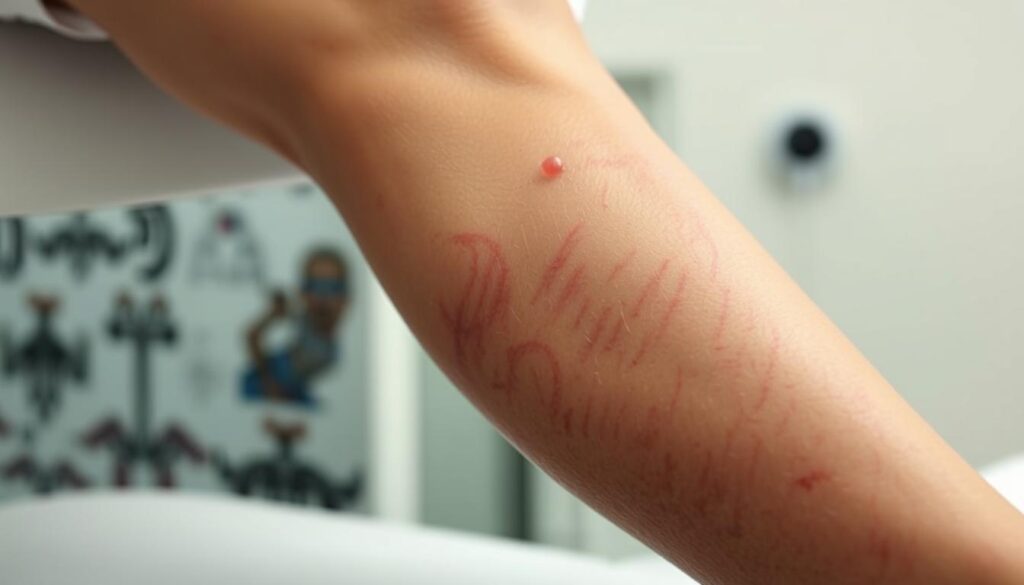
Individual Pain Tolerance
Getting a tattoo involves more than just the design. Your pain tolerance is key to how much discomfort you’ll feel. People react differently to pain, even in the same spot. Your age, gender, and mindset can change how you feel pain.
Studies show that older or heavier people might feel more pain. Women often report feeling more pain than men. A study found that women might feel pain more intensely than men.
Smokers might feel more pain during tattoos, too. This could be because nicotine affects how our bodies handle pain.
“The ribcage is mentioned as the most painful area for tattooing due to the lack of flesh and bones only.”
The ribcage, spine, and thin-skinned areas like the feet and ankles are very painful. But, places with more muscle and fat, like the upper arm, thigh, and forearm, are less painful.
Knowing your pain level can help you choose the best tattoo spot. It prepares you for what to expect. This way, you can enjoy the tattooing process more.

Cultural and Symbolic Significance
For many, the cultural meaning of tattoo pain and the significance of tattoo discomfort are key parts of getting a tattoo. In some cultures, the pain as part of the tattoo experience is seen as a rite of passage. It shows one’s commitment and strength.
The pain can also be a way to express oneself. It symbolizes one’s strength and resilience.
Tattoo Pain and Personal Expression
The cultural meaning of tattoo pain and its significance vary greatly. They depend on the wearer’s beliefs and culture. For example, in Maori culture, tattoos are sacred.
The pain as part of the tattoo experience is crucial. Traditional Maori tattoos, known as Tā moko, are carved into the skin with bone or stone chisels. This practice has been around for centuries.
“Each element in a Maori tattoo holds a specific meaning, varying based on placement, size, and person. Common Maori tattoo symbols include spirals, triangles, double spirals or waves, Manawa, Hei-Tiki, Hei Matau, Manaia, Koru, and Takitimu.”
In Maori culture, the significance of tattoo discomfort is deep. The tattooing process is a ritual, with ceremonies before and after. Enduring the pain shows one’s commitment to their culture and connection to ancestors.
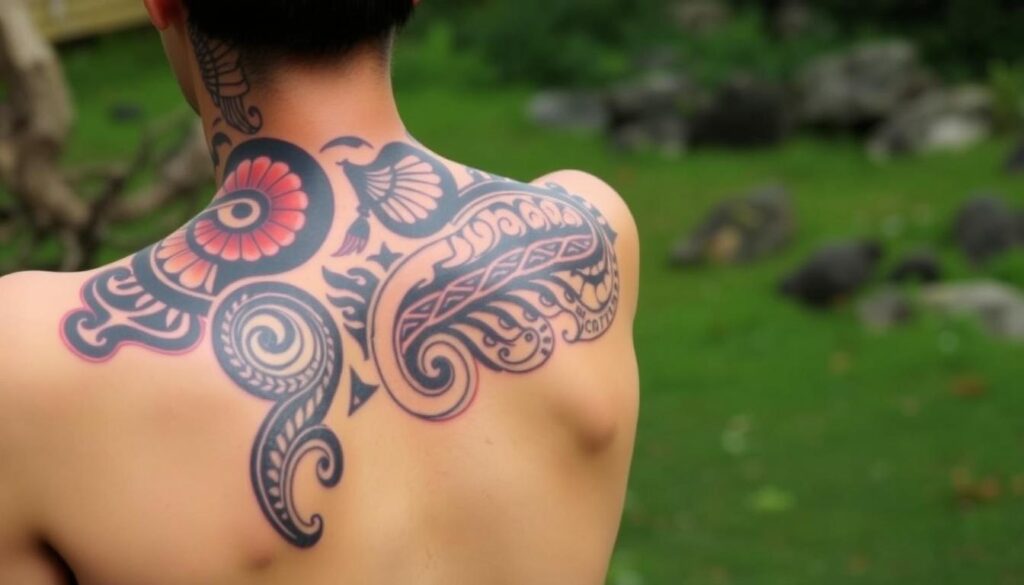
Maori tattoos have become popular worldwide, but debates on cultural meaning of tattoo pain and cultural appropriation exist. It’s crucial to teach people about the significance of tattoo discomfort and the cultural meanings of Maori tattoos. This ensures they are respected and appreciated correctly.
Conclusion
Understanding the skin on your shins is key before getting a tattoo. The skin is thin and close to bone, making it very painful. Knowing this helps you decide if a shin tattoo is right for you.
Think about where, how big, and how detailed you want your tattoo. This way, you can prepare for the pain. Taking good care of your tattoo after can also help with the discomfort.
When considering a shin tattoo, remember the skin’s thinness and bone closeness. Planning well can make the process less painful. This is true for any tattoo, so always think about your comfort and safety.
The shins are special because of their thin skin and bone proximity. This makes tattoos here very intense. Knowing this helps you plan better and enjoy your tattoo more.







